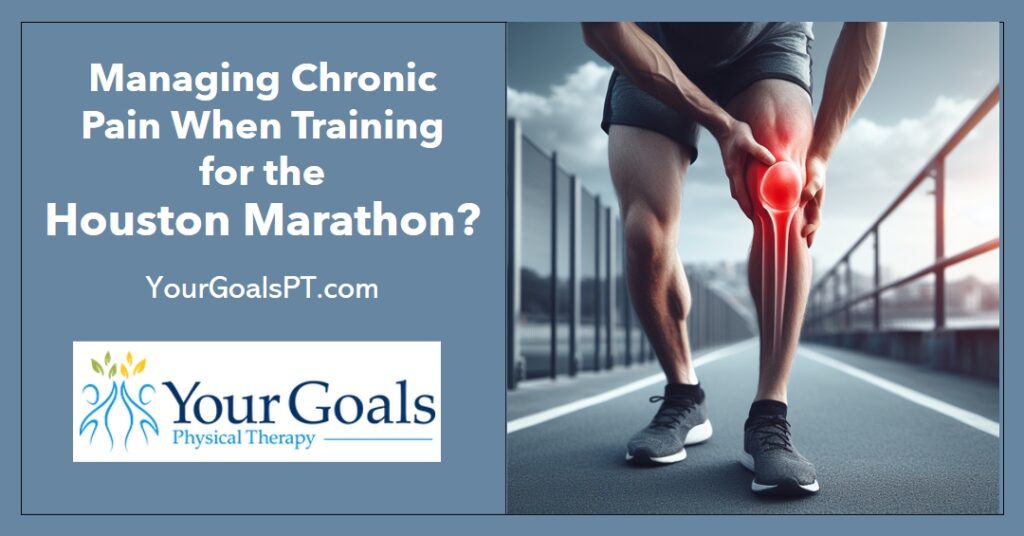
Training for marathons is a labor of love. It is time intensive and physically demanding. People who are training for something as intense as a 26.2 mile race assume they will have pain.
In fact, runners tend to accept any aches or pains as just part of the process. That is until they just can’t handle the pain any longer. When the pain is no longer just happening during their run but it is stopping them from running or the pain is still there while walking, sitting or standing during their normal daily day.
If you are training for a marathon and you have been dealing with pain that started off as more of an annoyance but has now progressed to interrupt not only your marathon training but also your everyday life.
You have already tried ice, biofreeze, foam rolling and every exercise or stretch you could find… And you aren’t sure what you should try next? This video is perfect for you.
I’m Dr. Molly with Your Goals Physical Therapy. I help runners end their aches and pains, so they can get back to running at the level they want. Without Medication, Injections or Surgery!
I’m going to give you 3 things to look for that will let you know when it is time to see a running specialist for your pain. Then I will talk about what it would mean to work with a running specialist.
When should you see a running specialist for your pain?
Training for a marathon is going to be uncomfortable and there will be longer runs and more intense runs that will cause muscle soreness. That is just a fact of training. However, that soreness shouldn’t last longer than 1-2 days.
No, exercises induced muscle soreness should last longer than 1-2 days. When you have soreness that lasts longer than a day or two that means your body has not recovered from that run. You can certainly have repetitive muscle soreness for instance, if you run 3 times a week you will more than likely be sore 3 days a week. What you are hoping for as you progress through your running training is that the intensity of your muscle soreness and the duration of your muscle soreness goes down over time, not up.
If as you progress through your running program your muscle soreness progressively increases that is a sign that your body is not fully recovering between runs. This is a great time to try taking a day off training, stretching, foam rolling, and ice to help your body recover.
I hear all the time, I’m fine for the first few miles but then this pain starts and it progressively gets worse as I run. As you run, you get tired. This is normal but if you are having pain, then that is your body telling you something is not working properly. I know that pain is uncomfortable and scary, however, pain is a gift from your body. It is your body’s way of communicating with you. What it doesn’t mean is that you have to stop running forever.
If while running you develop pain slowly over time, or at a specific distance, or with a specific speed an aspect of your running form is breaking down causing one part of your body to work harder than others. Which results in over use, then fatigue, and then pain.
Muscle burning while you run is normal, and therefore easy to ignore. Running is hard. Having muscle soreness after a run that resolves in 1-2 days is normal.
If you have muscle or joint pain that does not go away after your run and it starts to bother you while walking around or daily activities. This is not normal.
Pain that doesn’t go away after you stop running, and then progresses to interfering with simply walking around your home or at work, sitting at work or in your car, or standing in line, is not normal. It is time to find out what is happening.
Running should be an enjoyable experience! While it can be challenging, that’s part of what makes it fulfilling. Nobody wants to associate pain with fun, and running should definitely not be painful.
Muscle aches go away after 1- 2 days with some rest, ice or stretching….this is normal for running.
However, if you’re experiencing joint or muscle pain that has a sharpness to it, lasts for weeks or even months, and worsens over time to the point where it disrupts your daily life, or you’re concerned you may have to stop running altogether.
It is time to see a running specialist.
Our mission is to ensure that everyone can continue running for as long as they desire. Our approach begins with the mindset of addressing “What’s necessary to help you return to pain-free running”. When you start with this perspective, all you need to do is discover the steps that will lead you to your goal.
Running Assessment: A Running Screening: This is a 30 minute movement assessment. This gives you an initial, high-level overview of the underlying factors contributing to your discomfort. It’s a preliminary screening so it’s less specific than an evaluation and there is no treatment. Instead, think of it as a guided exploration. During this session, I will observe your movements, assess your running mechanics, and gather general information about your condition. This process reveals any apparent red flags and lets us determine if further investigation is necessary. The Running Screening is an excellent starting point to understand your situation & next steps before committing yourself to a full evaluation.
Evaluation: This is a 60 minute session where we will discuss your running concerns and through a detailed physical examination we will find the root cause of your pain while running, then create a personalized treatment plan that will get you back to running at the level you want.
I hope this information is helpful. Until we talk, have a great day.
We help active adults end their aches and pain, so they can reclaim their favorite recreational activities and live life to the fullest.

MEDICAL DISCLAIMER:
All information on this website is intended for instruction and informational purposes only. The authors are not responsible for any harm or injury that may result. Significant injury risk is possible if you do not follow due diligence and seek suitable professional advice about your injury. No guarantees of specific results are expressly made or implied on this website.